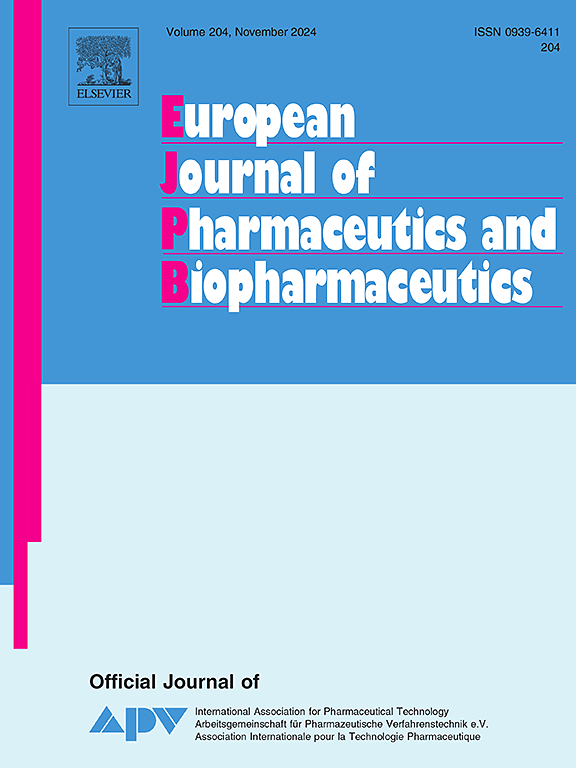Robust near-infrared modeling for pharmaceutical powder streams: External variable augmented iterative optimization technology (EVA-IOT)
IF 4.4
2区 医学
Q1 PHARMACOLOGY & PHARMACY
European Journal of Pharmaceutics and Biopharmaceutics
Pub Date : 2025-02-01
DOI:10.1016/j.ejpb.2025.114626
引用次数: 0
Abstract
The adoption of pure component models, such as iterative optimization technology (IOT) algorithms, is gaining significant interest in the pharmaceutical industry, primarily because of their calibration-free/minimal calibration requirements for process analytical technology applications. The IOT methods have recently demonstrated great potential for monitoring the quality of continuous powder mixtures by near-infrared (NIR) spectroscopy. However, the dynamic conditions of continuous manufacturing processes may limit the effectiveness of such approaches. Density variations introduced to NIR spectra that are collected from dynamic powder mixtures at different process conditions is detrimental to the drug prediction accuracy and robustness of IOT methods. This work introduces a new method, called external variable augmented iterative optimization technology (EVA-IOT), which incorporates the shape of non-chemical external sources of variability into the pure component spectra matrix to improve the prediction accuracy and robustness of the base IOT algorithm. This approach derives the shape of non-chemical external variables from the latent structure of decomposition methods using NIR spectra acquired from a single mixture at known levels of the external variable. A density-augmented EVA-IOT method was developed and implemented to quantify the active pharmaceutical ingredient (API) in continuous powder mixtures flowing at varying process conditions in a simulated continuous process. The EVA-IOT method demonstrated a significantly enhanced API prediction accuracy and robustness against process variation compared to alternative IOT methods. The overall prediction performance of EVA-IOT was comparable to that of global partial least square (PLS) regression models while reducing the calibration burden up to 97%. This makes EVA-IOT a material-sparing alternative to calibration-intensive robust decomposition modeling approaches for monitoring the quality of continuous pharmaceutical powder streams.

药物粉末流的鲁棒近红外建模:外部变量增强迭代优化技术(EVA-IOT)。
采用纯组件模型,如迭代优化技术(IOT)算法,在制药行业引起了极大的兴趣,主要是因为它们对过程分析技术应用的免校准/最小校准要求。物联网方法最近在近红外(NIR)光谱监测连续粉末混合物的质量方面显示出巨大的潜力。然而,连续制造过程的动态条件可能会限制这种方法的有效性。在不同工艺条件下从动态粉末混合物中收集的近红外光谱中引入的密度变化不利于物联网方法的药物预测准确性和鲁棒性。本文引入了一种新的方法,称为外部变量增强迭代优化技术(EVA-IOT),该方法将非化学外部变异性源的形状纳入纯成分光谱矩阵中,以提高基础IOT算法的预测精度和鲁棒性。该方法利用从已知外部变量水平的单一混合物中获得的近红外光谱,从分解方法的潜在结构中导出非化学外部变量的形状。开发并实施了一种密度增强EVA-IOT方法,用于在模拟连续过程中,在不同工艺条件下流动的连续粉末混合物中量化活性药物成分(API)。与其他物联网方法相比,EVA-IOT方法具有显著提高的API预测准确性和对过程变化的鲁棒性。EVA-IOT的整体预测性能与全局偏最小二乘(PLS)回归模型相当,同时减少了高达97%的校准负担。这使得EVA-IOT成为一种节省材料的替代方案,用于监测连续药物粉末流的质量,而不是校准密集型鲁棒分解建模方法。
本文章由计算机程序翻译,如有差异,请以英文原文为准。
求助全文
约1分钟内获得全文
求助全文
来源期刊
CiteScore
8.80
自引率
4.10%
发文量
211
审稿时长
36 days
期刊介绍:
The European Journal of Pharmaceutics and Biopharmaceutics provides a medium for the publication of novel, innovative and hypothesis-driven research from the areas of Pharmaceutics and Biopharmaceutics.
Topics covered include for example:
Design and development of drug delivery systems for pharmaceuticals and biopharmaceuticals (small molecules, proteins, nucleic acids)
Aspects of manufacturing process design
Biomedical aspects of drug product design
Strategies and formulations for controlled drug transport across biological barriers
Physicochemical aspects of drug product development
Novel excipients for drug product design
Drug delivery and controlled release systems for systemic and local applications
Nanomaterials for therapeutic and diagnostic purposes
Advanced therapy medicinal products
Medical devices supporting a distinct pharmacological effect.

 求助内容:
求助内容: 应助结果提醒方式:
应助结果提醒方式:


